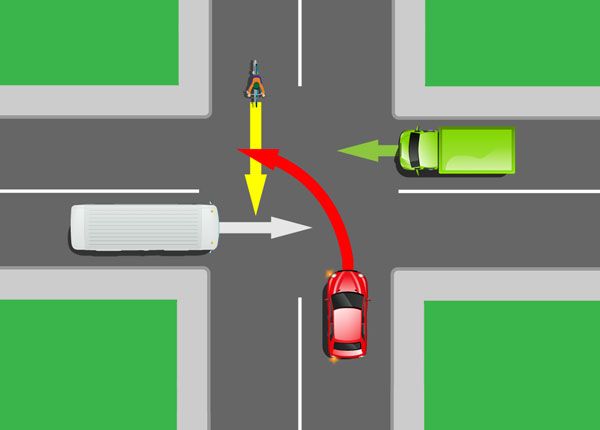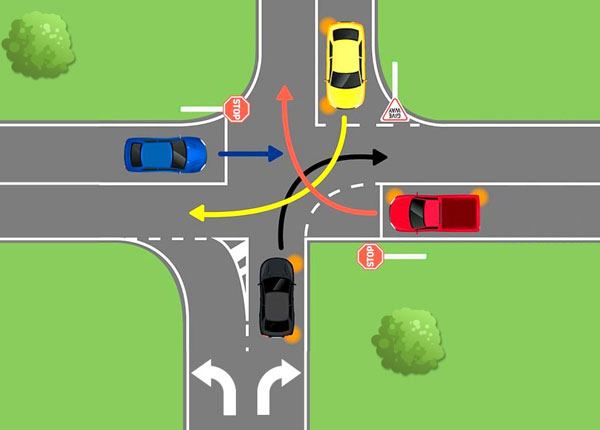
Coordinating Traffic Flow: Communication Skills for Drivers in 2020
Updated Oct. 21, 2020The term “traffic flow” describes the movement of traffic and interactions between individual travelers using the highway transportation system. In an ideal situation, traffic would flow in a continuous and orderly manner, to allow the maximum number of road users to move through a stretch of roadway in the shortest possible time. Traffic laws, traffic control devices and the layout of a road are designed to keep traffic flowing smoothly, efficiently and safely.
Despite the steps taken by the Federal Highway Administration and state governments to optimize traffic flow with these devices, “ideal” traffic conditions rarely occur. As every vehicle on a roadway is operated by an individual person, with free will and a unique driving style, things do not always run as smoothly as they should. When it comes to traffic flow, every choice an individual motorist makes matters. The actions you take while driving can either work to keep the entire transportation system running smoothly or disrupt it, for everybody.
Inconsiderate drivers often speed or behave in an otherwise irresponsible manner, as they assume it will help them to reach their destination sooner. In fact, these actions impede traffic flow and may very well lead to delays. By driving too fast, too close to other vehicles or maneuvering unexpectedly, you may force other motorists to do the same, which would then disturb further vehicles. The selfish actions of a single driver can have a domino-effect and disrupt traffic flow for hours, across many miles of roadway.
Optimizing traffic flow is the responsibility of all drivers – it requires teamwork. Traffic laws are put in place to give traffic flow the best chance of running smoothly but to make sure that happens, you must follow the rules, communicate with other road users and treat other drivers courteously. When all drivers obey the law and behave respectfully, everyone benefits from a safer and less-stressful driving environment.
Driver communication skills
If you wish to become a responsible driver and avoid penalties, developing effective communication skills is of paramount importance. We will discuss the communication tools at your disposal, and the situations in which they should be used. These tools are:
- The horn
- Signal lights
- Brake lights
- Hazard lights
Using these devices, motorists can warn road users around them whenever they wish to change their driving behavior. Any alteration in position or speed will take other drivers by surprise and disrupt the flow of traffic, if not properly communicated beforehand.
Remember that each of these in-built communication tools was designed with a specific purpose and should not be activated for any other reason. Drivers rarely switch on their turn signals or hazard lights without due cause, though the horn is often over-used. Sounding your horn can often do more harm than good, as it will startle other drivers and could cause them to stop, swerve or take another action that negatively affects the vehicles around them. Always use your horn sparingly.
Practice courteous driving
Becoming a courteous driver is more than simply being nice to other drivers on the roads, though that is one of its fundamental aspects. Driving courteously benefits everybody using the highway transportation network – yourself included – and makes the roadway a safer place. Courteous drivers respect the rules of the road and the needs of every driver using them, above their own personal desire to reach their destination as soon as possible.
To drive courteously, motorists must:
- 1

Signal their intentions.
You must signal your intentions and follow through in a timely manner. You will confuse other drivers by forgetting to deactivate a signal or canceling your indicator before following through with the maneuver. This can be just as disruptive as failing to signal your intentions at all. - 2

Consider their position on the roadway.
Keep an adequate bubble of space around your vehicle and make yourself as visible to other road users as possible. - 3

Be patient with other road users.
Some motorists will drive more hesitantly than others, such as learner drivers and older adults. Do not tailgate, sound your horn or express frustration in any other manner around these drivers, as this may upset them and worsen the situation. - 4

Not react to discourteous drivers.
If another motorist cuts in front of you or otherwise behaves in an inconsiderate manner, do not reprimand them by sounding your horn, gesturing or shouting. - 5

Let other vehicles out. Where possible, allow other drivers to merge into your lane by holding back slightly to give them space. Always yield to buses and other public transport vehicles seeking to pull out into the roadway.
- 6

Avoid holding people up.
If you are traveling slower than the road users around you, be mindful of the vehicles behind you and move over to let them pass where possible. Sometimes, other drivers will insist on overtaking you even when you are traveling at the speed limit. Do not try and prevent them from overtaking you, as this will simply make the maneuver more dangerous. When a heavy or slow-moving vehicle is attempting to pass you but taking a while to complete the maneuver, reduce your speed slightly to allow them the space to pass. - 7

Abide by all road rules, always.
Follow the instructions given by traffic control devices, avoid illegal parking, do not block alleys or driveways and yield the right-of-way when necessary.
Practicing courteous driving with this guidance will help everybody reach their destinations on time. Whenever possible, leave yourself more time than you need to complete your journey. It is far easier to be calm and courteous when you are not worrying about being late!




